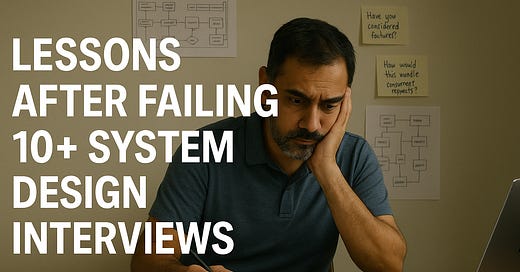8 Lessons After Failing 10+ System Design Interviews
Lessons from failing System Design Interviews
Over the past few years, I’ve interviewed at some of the best-known tech companies: Meta, Stripe, Uber, Google, and I’ve failed more than 10 system design rounds.
Not because I lacked experience. I’d led large-scale projects, shipped real-world systems, and mentored engineers. But I still walked into those interviews and fumbled.
System design interviews are different
They test not just what you know, but how you think, communicate, and prioritize under pressure
This post is a collection of painful (and honest) lessons so you can avoid the same traps I fell into.
Educative.io (Collaboration)
Educative.io is my favorite resource for interview preparation and I’ve already recommended their “Grokking the System Design” course a lot of times before
Educative.io runs multiple campaigns to support developers navigating industry changes, including recent performance-based layoffs. You can check the discounts using the button below
Back to the topic, let’s dive deep into the mistakes and the lessons
Mistake #1: Letting the interviewer drive the interview
In many early rounds, I’d just wait. Wait for the interviewer to ask the next question, to guide the flow, to call out what’s missing. I thought being passive was being “collaborative.” But it made me seem unsure, unstructured, and junior.
What I do now:
I take control early. After clarifying requirements, I lay out a clear roadmap: “I'll first talk about requirements, then propose a high-level design, and finally go deeper into storage and scaling.”
This sets the tone and shows I know how to lead conversations, just like I would in a design review at work.
🧏♂️ Mistake #2: Missing subtle interviewer hints
Interviewers often drop clues:
“How would this work at scale?”
“What happens if this service crashes?”
“Would this create a bottleneck?”
In the beginning, I missed these hints. I assumed they were rhetorical, or that my current answer was enough. But these are invitations, chances to go deeper and show depth.
What I do now:
I pause and say, “That’s a great point, I hadn't considered that failure path. Let me walk through how we might handle it.”
Recognizing these prompts shows you’re listening, self-aware, and able to course-correct are all signs of a senior engineer.
📄 Mistake #3: Not writing or drawing enough
I used to just explain my ideas verbally, skipping diagrams, APIs, data models. The conversation felt fluid, but I left the interviewer guessing.
Worse, I lost track of what I’d covered.
What I do now:
I treat every interview like a whiteboard session. I draw high-level architecture, clearly label components, and write out key APIs and data flows. It gives structure to my thinking and makes it easier for the interviewer to engage.
If I mention rate limiting, I’ll write on the doc even if there was just a mention. It helps interviewer to prepare notes after the interview
🔍 Mistake #4: Jumping into components too early
In my excitement, I’d start breaking things down into microservices within the first 5 minutes. Without nailing down use cases, constraints, or key tradeoffs, the design lacked focus.
What I do now:
I slow down. I ask clarifying questions:
“Are we optimizing for latency or cost?”
“What’s the expected scale on day one vs peak?”
“Is consistency or availability more important here?”
I then summarize the problem before diving into design. It’s a small move, but it signals maturity.




